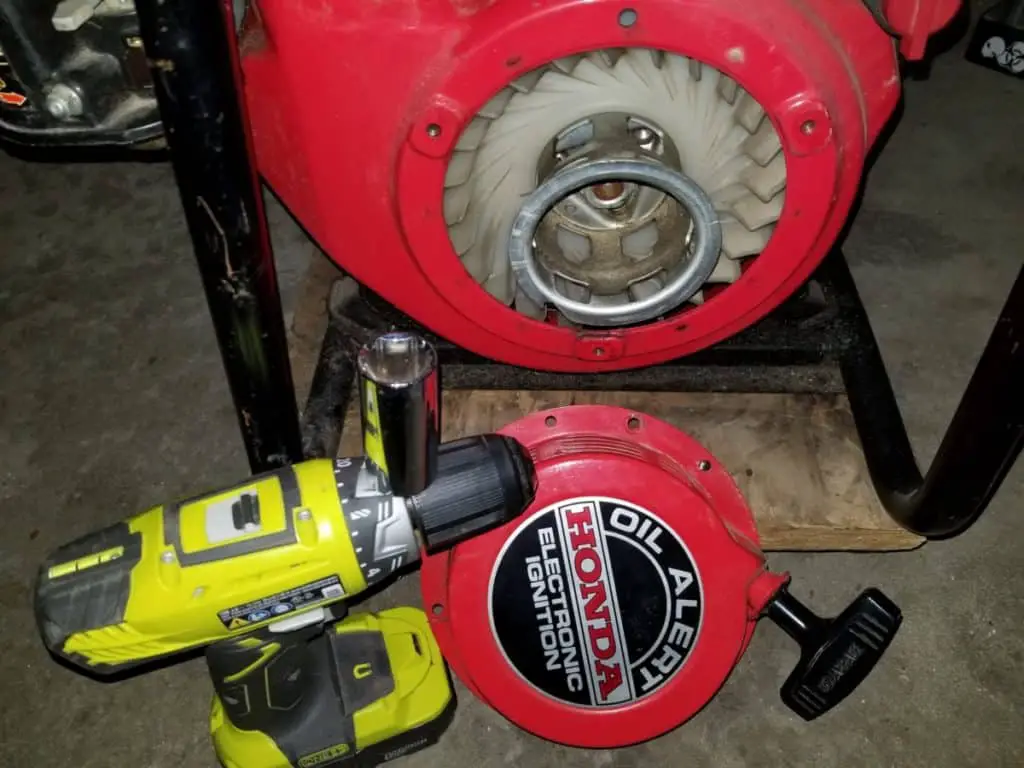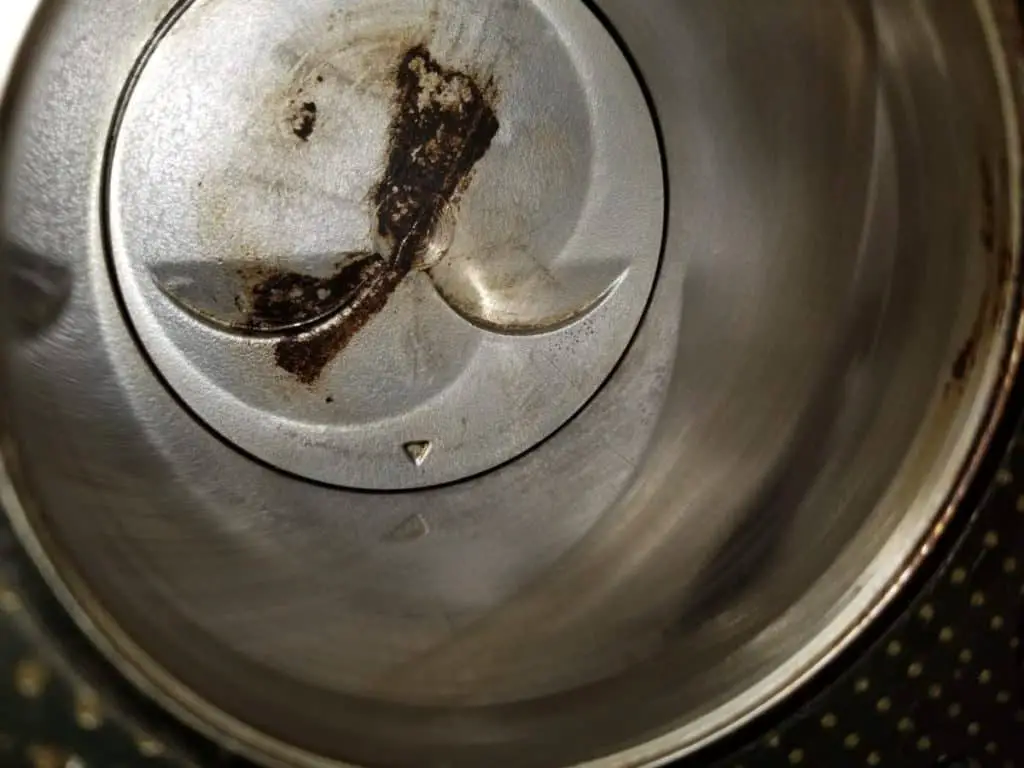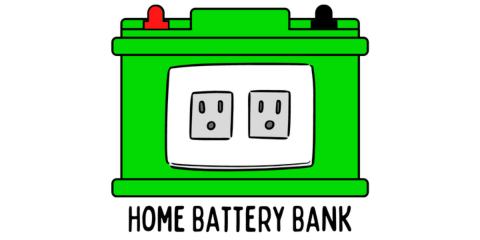Throwing out your shoulder in the middle of a power outage as you are trying to start your generator is definitely not in the dictionary as a definition of a good time.
Unfortunately though, having a generator that is difficult to start by hand happens to the best of us. Thankfully, it’s generally an easy fix if you’ve been taking care of your unit.
As a general rule, a generator will be hard to pull start due to hydrolock in the cylinder, a malfunctioning recoil start assembly, a damaged flywheel or flywheel keys, the piston is seized, or the compression release is broken.
Why is My Generator Hard to Pull Start?
| Reason | Cause | Fix |
|---|---|---|
| Hydrolock | Liquid Oil, Gas, or Water sitting on the Piston | Remove sparkplug, pull cord rapidly to flush chamber, change oil |
| Recoil Start Assembly | Spring or Rope are compromised | Reassemble (Video Below) |
| Flywheel/Key | Cracked Flywheel or sheared flywheel key | Have Serviced by Professional |
| Piston Seized | No oil, rust, or engine failure from overheating (no oil) | Check oil, add small amount of oil to combustion chamber through spark plug hole |
| Compression Release | Compression Release Assembly broken inside the Crankcase | Have serviced by professional |
I’ve cover each of these 5 reasons in a bit more detail and what you can do to resolve the issue. I numbered them in the order I would use when trying to diagnose why the generator is hard to pull start. It’s best to start with the simplest explanations first and progressively dig into the generator further as needed.
Let’s get to it!
Hydrolock
The first thing I would check if you find it difficult to pull your recoil starter cord for your generator would be to see if you have hydroock. Hydrolock is when you have a liquid sitting on top of the piston inside of the combustion chamber.
The piston cannot compress liquid but it can compress gasses, so if you have oil, gasoline, or water sitting on top of your piston then it will be physically impossible for you to pull the recoil starter cord since you cannot overcome the laws of physics. Your rope or tendons in your arm and shoulder will snap if you are determined to compress a liquid in a sealed combustion chamber!
What you’ll want to do is first remove the rubber boot that snaps onto the spark plug and then remove the spark plug with a spark plug removal tool or deep-well socket and ratchet. Then use a flashlight to see if you have any liquid inside the combustion chamber.
If you can see liquid, carefully use a thin dowel with a piece of a clean rag attached with tape to dip down into the liquid. Knowing if it’s water, gas, or oil can help you diagnose exactly why you have this problem to begin with.
With the spark plug removed and the generator outside, keep your face out of the way of the sparkplug hole and slowly and gently pull on the starter cord.
Did it get any easier?
If it did, then you definitely have hydrolock.
If you still can’t pull, proceed to the next section. If you can, continue with this section.
If you’re able to now gently pull the cord, make sure your generator is outside and shield your face as you rapidly pull the cord several times to flush out the cylinder. When I say flush out I mean all of the liquid contents will come shooting out the spark plug hole and will fly 10′ up in the air.
Once this is done you can now strew back in the spark plug, reattach the boot, and your generator should fire up (at least temporarily).
Let’s look at the causes really quickly below.
Hydrolock can occur if your generator has tipped over or been on a hard angle for too long and oil can seep up past the piston rings and sit on top of the piston. If oil was on the end of the cloth rag that you dipped in, then flushing it like you did above should be all you need to do. Of course, check your oil levels first.
Hydrolock can also happen because of gas if you have a float needle valve that is not functioning properly in your carburetor and will not stop the flow of gasoline entering the carburetor bowl. This gasoline will flood up to the top of the carburetor and then drain out the throat of the carburetor either through the air filter side or back into the combustion chamber depending on what angle you’re generator is sitting during storage.
If you had gasoline on your rag that you dipped in, then you will need to clean out your carburetor as it will keep flooding. I have an entire step-by-step article and video here to guide you through the process. You will also need to change the oil since gasoline has undoubtedly seeped down into your crankcase as it worked itself between the piston and the cylinder.
Hydrolock can also be caused by water being inside of your combustion chamber if you left your generator outdoors and water can enter in through the exhaust if it rains hard enough. That water can also lead to rust which can also seize up your piston but we’ll get to that later.
If you had water on your rag that you dipped into the combustion chamber, then you can proceed with running it after you flushed it like I mentioned earlier AND after you change your oil, since water is probably mixed in with it.
Recoil Start Assembly (Pull Cord Itself)
If hydrolock was not your problem, I would then check to see if it’s just the recoil starter cord itself. Sometimes the rope can get bound up on itself and jammed up inside.
These assemblies are not that difficult to fix and I have a video link below where you can see me reassemble a fully disassembled one and it also shows how to start a generator with just a piece of rope if your recoil starter assembly is beyond repair.
Damaged/Cracked Flywheel or Flywheel Key
If hydrolock and a recoil starter assembly is not your issue, then you’re next going to want to looking at your flywheel to see if there’s any damage or if the fly wheel keys are damaged as well.
To access this you’re going to have to remove the starter recoil assembly (as we did in the previous section) and remove the starter cup and the fan disc.

Beyond that is the flywheel and right where the flywheel is connected to the shaft in the center you’ll see the flywheel keys. Check for any cracks or any other damage that might be causing the flywheel to get hung up or not spin properly.
Piston Seized-Up
Now that we have crossed off the top 3 easiest reasons, we’re going to proceed to look at your piston to see if it’s seized up for one reason or another.
This could be due to running the generator without oil or enough oil and the piston is not lubricated and cannot move (at all or easily) within the cylinder. If your oil is very low, fill it accordingly and you can also drop a tablespoon of it into the combustion chamber through the sparkplug hole and let it sit for a little bit. After an hour or so, try gently pulling the recoil cord with the spark plug still removed to see if the added lubrication has allowed the piston to free itself.

It could be that the piston was run without oil for too long and the excessive heat is actually caused the piston to bind with the cylinder. This is known as catastrophic engine failure. If that’s the case you’re definitely not going to get things running and you’re probably going to be looking for a new generator as opposed to the money it costs to fix such a thing.
Your piston could also be rusted up due to a lack of oil or having water come in through your exhaust and sit on top of your piston and seep down.
Camshaft Compression Release Damaged (Rare)
Finally, if it’s none of the aforementioned reasons were your issue, then you might have a damaged compression release on the camshaft inside of the crankcase.
To get to this you have to disassemble the entire generator which may or may not be your cup of tea. I enjoy repairing generators and other small engines as a hobby, but this is one that I might kick over to a mechanic and pay for it to be done.
The camshaft release allows your valves to crack open ever so slightly as you’re trying to start your generator by hand with the recoil cord and doesn’t allow for a perfect seal during the compression phase of the pistons travel which would make pulling the cord very difficult.
Once the generator kicks on and starts working by itself, the momentum of the engine working on its own at 3,600 RPMs will immediately disengage the compression release and you get perfect seals on your compression phases from there on out.
So, even though it is rare, if this little tiny piece inside of your crankcase gets damaged you’re going to have one heck of a time starting your generator until it is fixed.
